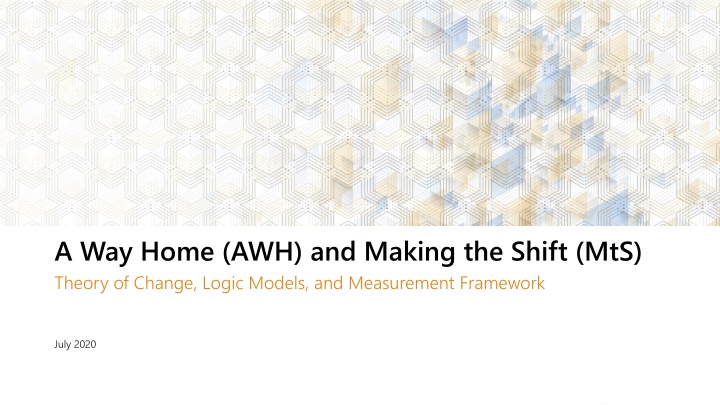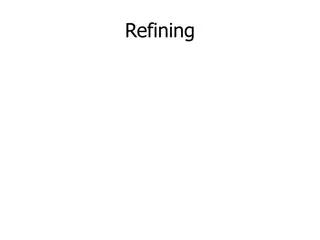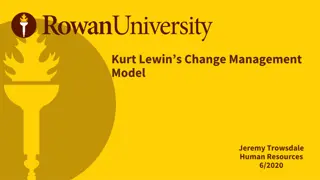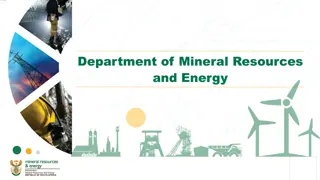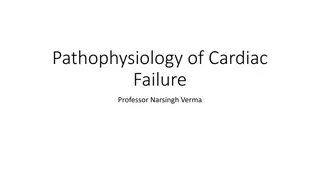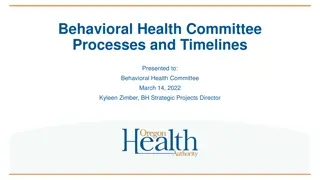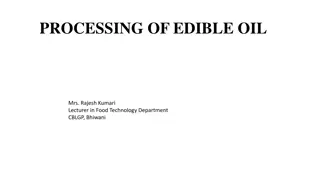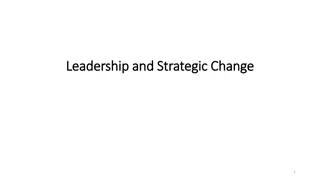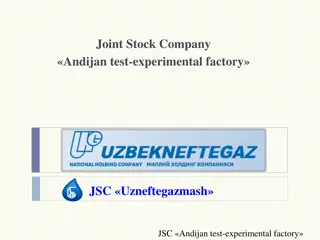Refining AWH and MtS Theory of Change
Building on the existing work by AWH and MtS, this presentation presents a refined version of AWH's Theory of Change and Logic Model, identifies connections between the work of AWH and MtS, and provides specific, attainable, and measurable outcomes for evaluation.
Download Presentation

Please find below an Image/Link to download the presentation.
The content on the website is provided AS IS for your information and personal use only. It may not be sold, licensed, or shared on other websites without obtaining consent from the author.If you encounter any issues during the download, it is possible that the publisher has removed the file from their server.
You are allowed to download the files provided on this website for personal or commercial use, subject to the condition that they are used lawfully. All files are the property of their respective owners.
The content on the website is provided AS IS for your information and personal use only. It may not be sold, licensed, or shared on other websites without obtaining consent from the author.
E N D
Presentation Transcript
A Way Home (AWH) and Making the Shift (MtS) Theory of Change, Logic Models, and Measurement Framework July 2020
Purpose Building on existing work by AWH and MtS, this deck: Presents a refined version of AWH s Theory of Change and Logic Model Identifies connections between the work of AWH and MtS Provides specific, attainable, and measurable outcomes for AWH and a data collection strategy to evaluate these outcomes 2
Contents 1. AWH Narrative Theory of Change 2. AWH Logic Model 3. MtS-AWH Logic Model 4. Measurement Framework and Data Collection Strategy 3
AWH Narrative Theory of Change Describes AWH s pathways of change, the context in which it operates, and the assumptions and rationale that underlie its approach 4
AWH Narrative Theory of Change CONTEXT Existing approaches to addressing youth homelessness need to be improved to be more proactive and equipped to tackle the systemic and structural issues that cause youth homelessness. AWH aims to transform the response to youth homelessness by conducting research, testing innovative approaches, and mobilizing knowledge about prevention- focused approaches, improving policy, planning, and practice, facilitating partnerships, and applying a collectiveimpact approach to their work. ASSUMPTIONS Communities could benefit from support to overcome systemic barriers to shifting to a prevention-focused approach to youth homelessness Testing innovativesolutions, generating evidence about what works and how, and providing thought-leadership about prevention-focused approaches will address knowledge gaps and shift how policy-makers and service delivery organizations create and implement solutions to youth homelessness A rights-based approach to youth homelessness recognizes that homelessness is a result of systemic patterns of inequality and exclusion and it is a responsibility of governments to address or to act on on homelessness as a human rights issue Improving systems planning approaches will help address the systemic and structural issues that underlie youth homelessness Providing training, resources, and technical assistance to service delivery organizations will enhance their knowledge and capacity to prevent and address youth homelessness Engaging a broad range of stakeholders will increase coordination and collaboration in the youth homelessness ecosystem to prevent youth homelessness EVIDENCE A Way Home is applying a collective impact and systems change approach by working across sectors and stakeholders, addressing systemic and structural issues, and testing new and innovation solutions to issues (Kania & Kramer, 2012). A Way Home has created a strong implementation strategy (a well-defined, common agenda, shared measurement system, and strong equity focus) vital to the success of a collective impact or systems change initiative (Lynn et al, 2018). By providing training, resources, and technical assistance to improve systems planning and systems integration, A Way Home is building the capacity of the homeless service workforce, which are crucial in attracting and retaining qualified workers at the frontlines of addressing homelessness (Mullen and Leginski, 2010). While it is essential to improve coordination within the homelessness ecosystem, A Way Home is also targeting inter-sectoral gaps (e.g. youth justice, child welfare services, mental health) that are vital in generating the desired effect on the numbers of youth experiencing homelessness (Nichols, 2008) ENABLERS Internal AWH s capacity and expertise to implement its planned activities The strength of AWH s relationships with network partners and key stakeholders, and AWH s ability to leverage this to maximize its impact AWH s use of feedback and insights from its network partners and learning communities to adjust and tailor their approach and activities External Time and capacity among service delivery organizations to adopt and utilize tools and resources developed by AWH A political will among policy and decision-makers to invest and support prevention-focused approaches A Way Home s work is: Youth-priority driven | Prevention-oriented | Rights-based | Evidence-driven | Solutions-focused A Way Home values: Co-creation | Equity, diversity & inclusion | Reconciliation | Holistic accountability 5
AWH Logic Model Outlines AWH s inputs and activities and how it contributes to AWH s desired outcomes 6
Short-term outcomes (Influence) Medium-term outcomes (Leverage) Long-term outcomes (Impact) Inputs Activities A Way Home staff and expertise Youth Persons with Lived Experiences Canadian Observatory on Homelessness (COH) network, staff and expertise Network partners INNOVATION, RESEARCH AND KNOWLEDGE MOBILIZATION generate and share knowledge about what works and how Co-lead the MtS Innovation Lab and MtS Demonstration Lab Implement and share tools, resources, training and technical assistance Support Upstream demonstration projects Duty to Assist pilots Attend and present at events and conferences Funders and policy-makers Increased awareness and understanding of prevention-focused practices advocated through: research and knowledge mobilization, National Youth Survey and Roadmap for Prevention of Youth Homelessness Increased experimentation with or uptake of prevention- focused policies and programs POLICY engage governments to foster policy shifts to enable prevention of youth homelessness Engage FPT government partners on MtS research and practice, National Youth Survey learnings, and Roadmap for the Prevention of Youth Homelessness Support communities to engage PTs Funders (foundations and community entities) Federal and P/T governments (Ministries of Housing, Children & Youth, Health, Justice, Education, and those responsible for income supports) COLLECTIVE IMPACT AND SYSTEMS CHANGE APPROACH Systems transformation: making the shift to prevention-focused policies, programs, and practices PARTNERSHIPS build strategic partnerships in ecosystem to amplify prevention efforts Increase partnerships with social impact organizations Learning exchanges with communities and countries that have adopted the AWH brand Co-convene the AWH Funders Table and work towards strategic alignment of funders Participate in Steering Committee on National Alliance to End Rural and Remote Homelessness COALITION BUILDING leverage networks and expertise of cross-sector coalition partners in Canada and abroad to advance the AWH agenda Co-lead the MtS Networks of Centres of Excellence with COH and engage partners in projects and research network Promote and support COH s evidence generation activities through knowledge mobilization and dissemination Facilitate ongoing learning exchanges with communities and countries that have adopted the AWH brand Partner with COH and government on Point-in-Time processes Partners Increased awareness and understanding of practices that AWH is promoting Increased Partnerships with Indigenous leaders and communities Municipal governments MtS Social Innovation Lab (staff and expertise) MtS Demonstrations Labs (staff and expertise) MtS Research Network experimentation with or uptake of practices that AWH is promoting Prevention and reduction of youth homelessness leads to improved social and economic well-being of youth, families and communities 7 PLANNING enhance capacity for systems planning Develop and implement tools, resources, training and technical assistance to support communities, provinces and territories to do evidence-led planning Practitioners and service delivery organizations Increased awareness and understanding of systems Increased experimentation with
AWH-MtS Logic Model Outlines how MtS contributes to the work and desired outcomes of AWH 8
Connections to MtS MtS Theory of Change can be mapped to two of AWH s core activities: Innovation, research and knowledge mobilization Partnerships and coalition building 9
MtS contributions to AWH Short-term outcomes (Influence) Medium-term outcomes (Leverage) Long-term outcomes (Impact) Inputs Activities COLLECTIVE IMPACT AND SYSTEMS CHANGE APPROACH A Way Home staff and expertise Canadian Observatory on Homelessness (COH) staff and expertise MtS Social Innovation Lab (staff and expertise) MtS Demonstrations Labs (staff and expertise) MtS Research Network Networks of Centres of Excellence infrastructure INNOVATION, RESEARCH AND KNOWLEDGE MOBILIZATION generate and share knowledge about what works and how Co-lead the Making the Shift Innovation Lab and Making the Shift Demonstration Lab with COH Conduct high-quality research with equity and diversity lens Conference presentations Newsletter Policy briefs Publications Community of Practice Funders, policy-makers, and service delivery organizations Increased awareness and understanding of effective, prevention-focused practices and program models identified through MtS Increased experimentation with or uptake of practices and program models identified through MtS Systems transformation: making the shift to prevention-focused policies, programs, and practices Contributions to Partners PARTNERSHIPS AND COALITION BUILDING with coalition members, build strategic partnerships in ecosystem to amplify prevention efforts Co-lead the MtS Networks of Centres of Excellence with COH and engage partners in projects and research network Training and development Engagement with researchers Facilitate ongoing learning exchanges with communities and countries that have adopted MtS Engage international partners Engage HQP Building network and partnerships Solicit partner contributions Establish board and manage network Increased awareness and understanding of MtS and its outputs Increased experimentation with or uptake of MtS and its outputs Prevention and reduction of youth homelessness leads to improved social and economic well-being of youth, families and communities 10
Measurement Framework and Data Collection Strategy A plan for how AWH can track its outputs and outcomes as described in the logic model, including indicator definitions and data sources 11
Measurement Framework Outputs Activities category Output indicators Data Sources & Collection A Way Home # and quality of research, evidence generation and knowledge mobilization outputs (Links to Mts) # of funded projects and demonstration sites # and strength of connections with non-academic partners # of research/technical reports # of conference presentations # of policy briefs # of publications # of citations/references to AWH reports Internal dashboard Internal dashboard Making the Shift Innovation, research and knowledge mobilization Excellence of the Research Program 100% ethical clearance rate # of network applications Equilibrium between academic and community partners High-quality project selection process #/% of projects involving PWLE #/% of Indigenous-led research projects # of peer-reviewed articles Knowledge Mobilization # of HQP tools # of conference presentations # of webinars # of learning sessions # of HQP publications and presentations # of international conference presentations # of products produced by community organizations # of newsletter issues # of newsletter subscribers % of year over year growth 12
Measurement Framework Outputs contd Data Sources & Collection Activities category Output indicators A Way Home # and type of presentations at conferences and events # of funders joining AWH funders table # of new partnerships with social impact organizations # of collaborations/engagement with non-coalition partners # of international organizations/coalitions that have adopted the AWH brand Internal dashboard Internal dashboard Network Member Reports Social Network Analysis maps Web-analytics Board Engagement and Satisfaction Survey Making the Shift Training and Development # of HQP with lived experience # of LivEx members # of Post Doc COP members # of positions & fellowships # of HQP learning sessions/training modules # of research/technical reports # of conference presentations # of peer-reviewed articles # of policy briefs # of publications # of newsletter subscribers Networking and Partnerships Program $$ leveraged # of demonstration sites Connectivity strength (e.g. SNA) # of projects brought to scale # of international partners Results of SNA/Network maps # of funded projects Nature and extent of partner contributions # of networks & MOUs % of year over year growth Management of the Network Succession plan International designation Board Diversity & Equity Indicators Board Engagement & Satisfaction rates Partnerships and coalition building 13
Measurement Framework Outputs contd Activities category Output indicators Data Sources & Collection Planning Tools and resources developed, number of users Training and technical assistance provided, number of users # of systems planning electives taken in a year # of 1-on-1 coaching delivered in a year # of systems planning modules Internal dashboard Practice # and type of National Learning Community events # of Community of Practice calls # of individuals who engage in online courses # of webinars hosted # of webinar attendees # of Systems Planning Collective trainees Training and technical assistance provided, number of users Users of YAP tool Users of LGBTQ2S toolkit Internal dashboard Policy # and type of engagements with FPT governments # of meetings with policy-makers Internal dashboard 14
Measurement Framework Short-term outcomes Outcomes Indicators Data Sources & Collection Funders and policy makers Increased awareness and understanding of prevention-focused practices advocated through: research and knowledge mobilization, National Youth Survey and Roadmap for Prevention of Youth Homelessness A Way Home Targeted funders and policy-makers report awareness and understanding of learnings and recommendations from: Research and knowledge mobilization activities National Youth Survey Roadmap for Prevention of Youth Homelessness Key informant interviews Commitment Curve Surveys MtS Innovation Lab and MtS Dems reports Making the Shift Targeted funders and policy-makers report awareness and understanding of learnings and recommendations from: MtS Innovation Lab and MtS Demonstration Lab results Key informant interviews Commitment Curve Surveys Partners Increased awareness and understanding of practices that AWH is promoting A Way Home Partners report knowledge, awareness and understanding of policies and practices that AWH is promoting Funders table funding prevention focused practices Other partners focus on shifting practices and policies towards prevention Key informant interviews or surveys, conducted annually or bi-annually Making the Shift Indigenous peoples knowledge and scholars with lived experience help shape the research agenda Partners participate in monitoring progress towards the intended goals and participate in identifying opportunities, challenges, gaps and overlaps. Most Significant Change Story Social Network Analysis Maps Network Member Reports Practitioners and service delivery organizations Increased awareness and understanding of systems planning approach Increased awareness and understanding of early intervention and prevention practices National Learning Community members report knowledge and awareness of prevention- focused practices Community organizations receiving systems planning support report increased commitment to adopting systems planning approach Commitment curve surveys of National Learning Community members, conducted annually Key informant interviews or surveys with community organizations receiving systems planning support 15
Measurement Framework Medium term outcomes Outcomes Indicators Data Sources & Collection Funders and policy makers Increased experimentation with or uptake of prevention-focused policies and programs A Way Home Targeted funders and policy-makers test or implement prevention-focused policies and programs from: National Youth Survey Roadmap for Prevention of Youth Homelessness Commitment curve surveys Key informant interviews Making the Shift Targeted funders and policy-makers report test or implement prevention-focused policies and programs from: MtS Innovation Lab and MtS Demonstration Lab Research and knowledge mobilization activities Partners Increased experimentation with or uptake of practices that AWH is promoting A Way Home Partners test or implement policies and practices that AWH is promoting through: Funders table funding prevention focused practices Other partners test practices and policies towards prevention Key informant interviews Internal dashboard Making the Shift Partners test or implement policies and practices that MtS is promoting through: MtS Networks of Excellence with COH Engaging partners in projects and research network Practitioners and service delivery organizations Increased experimentation with and uptake of systems planning approach Increased experimentation with or uptake of early intervention and prevention practices National Learning Community members report testing or implementing prevention- focused practices Community organizations receiving systems planning support report test or adopt systems planning approach Key informant interviews Case studies of select service delivery organizations who have implemented AWH s tools/resources, participated in AWH s activities 16
Measurement Framework Long-term outcomes Outcome Indicators Data Sources & Collection Systems transformation: making the shift to prevention-focused policies, programs, and practices Funders, policy-makers, partners, practitioners and service delivery organizations make changes in the policy and service delivery landscape that advances the prevention, reduction, and ending of youth homelessness over a reactive model. Policy tracking to track targeted changes to the policy environment surrounding youth homelessness over the course of A Way Home s (e.g. changes in laws, regulations, government policy, funding structures, and allocations) Case studies - To collect in-depth information about the ultimate impacts achieved through AWH s work in select communities through in-depth consultations with community partners Prevention and reduction of youth homelessness leads to improved social and economic well-being of youth, families and communities 17
